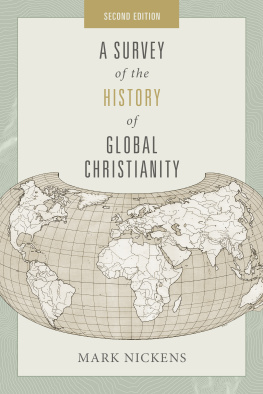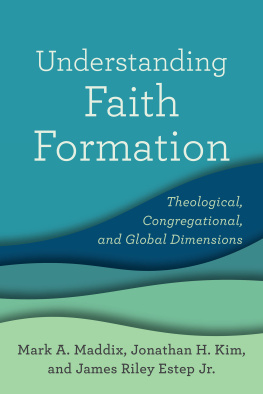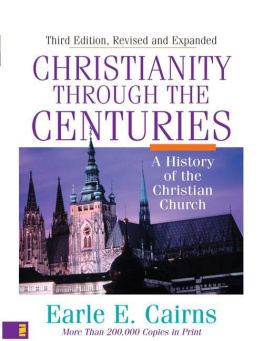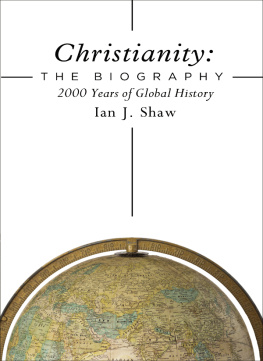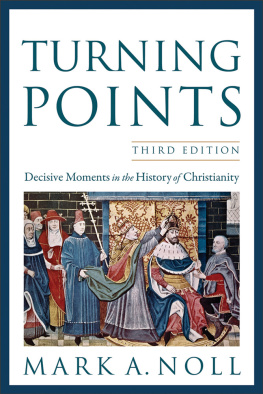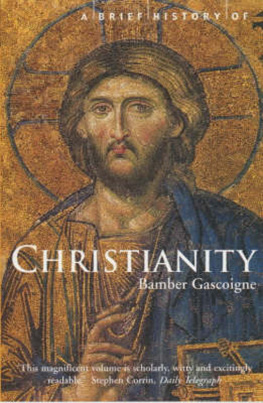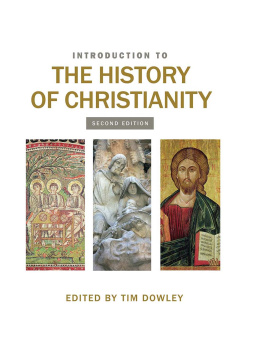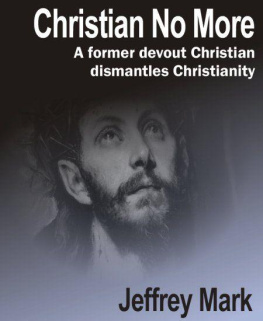Mark Nickens - A Survey of the History of Global Christianity, Second Edition
Here you can read online Mark Nickens - A Survey of the History of Global Christianity, Second Edition full text of the book (entire story) in english for free. Download pdf and epub, get meaning, cover and reviews about this ebook. year: 2020, publisher: B&H Publishing Group, genre: Religion. Description of the work, (preface) as well as reviews are available. Best literature library LitArk.com created for fans of good reading and offers a wide selection of genres:
Romance novel
Science fiction
Adventure
Detective
Science
History
Home and family
Prose
Art
Politics
Computer
Non-fiction
Religion
Business
Children
Humor
Choose a favorite category and find really read worthwhile books. Enjoy immersion in the world of imagination, feel the emotions of the characters or learn something new for yourself, make an fascinating discovery.
- Book:A Survey of the History of Global Christianity, Second Edition
- Author:
- Publisher:B&H Publishing Group
- Genre:
- Year:2020
- Rating:5 / 5
- Favourites:Add to favourites
- Your mark:
- 100
- 1
- 2
- 3
- 4
- 5
A Survey of the History of Global Christianity, Second Edition: summary, description and annotation
We offer to read an annotation, description, summary or preface (depends on what the author of the book "A Survey of the History of Global Christianity, Second Edition" wrote himself). If you haven't found the necessary information about the book — write in the comments, we will try to find it.
Mark Nickens: author's other books
Who wrote A Survey of the History of Global Christianity, Second Edition? Find out the surname, the name of the author of the book and a list of all author's works by series.
A Survey of the History of Global Christianity, Second Edition — read online for free the complete book (whole text) full work
Below is the text of the book, divided by pages. System saving the place of the last page read, allows you to conveniently read the book "A Survey of the History of Global Christianity, Second Edition" online for free, without having to search again every time where you left off. Put a bookmark, and you can go to the page where you finished reading at any time.
Font size:
Interval:
Bookmark:


A Survey of the History of Global Christianity, Second Edition
Copyright 2020 by Mark Nickens
Published by B&H Academic
Nashville, Tennessee
All rights reserved.
ISBN: 978-1-5359-8500-0
Dewey Decimal Classification: 270
Subject Heading: CHURCH HISTORY / CHRISTIANITY / DOCTRINAL THEOLOGY
All Scripture quotations are taken from the Christian Standard Bible, Copyright 2017 by Holman Bible Publishers. Used by permission. Christian Standard Bible and CSB are federally registered trademarks of Holman Bible Publishers.
The web addresses referenced in this book were live and correct at the time of the books publication but may be subject to change.
Cover design by Emily Keafer Lambright. Map image created by Erwin J. Raisz, Raisz Landform Maps. Used with permission.
Printed in the United States of America
1 2 3 4 5 6 7 8 9 10 25 24 23 22 21 20
BTH
What to Expect
Welcome to a study of the history of global Christianity. After teaching church history in many schools, over many decades, and in different countries, I realized that most people develop an interest in church history for the same reason. Their interest peaks once they come to the same conclusion: church history not only explains why other Christians believe and act the way they do, but it also explains about oneself, why we each believe and act the way that we do. Therefore, since each church history book is designed to tell the story of Christianity with a certain focus, the focus of this book is to answer one question: Why? For example: Why does that group believe that? Why does my church do this? Why do I do what I do? Why is there one Bible but so many different Christian groups, churches, and denominations (or nondenominational church groups)?
All your why questions about the vast array of different Christian groups, movements, and ideas do have answers. Those answers are found by studying church history, with many of them are answered in this book. Here you will uncover answers to questions you have long pondered, and you will also learn the answers to questions you never thought to ask.
Therefore, as you read through this book, please pay attention to the explanations of different actions, reactions, and motivations in the developing of new doctrines, practices, churches, groups, and even denominations. Christians began most innovations for one of two reasons: they either reacted against another group, or they believed that a group was lacking and developed an alternative doctrine, practice, and so on. You will discover many of those reasons here, which will help you better understand why Christianity has one sacred writing, the Bible, and yet so many different groupings within Christianity, all stemming from that one Bible. In addition, you will find some of your own beliefs and practices explained and, therefore, will learn more about your own faith.
This will be a great trip as you learn how Christianity developed from a small group of followers at the Day of Pentecost in Jerusalem to encompassing the world today with over two billion followers.
Mark Nickens
Acknowledgments
This book was the result of studying church history for over thirty years, teaching it in traditional settings and online classes in over fifteen schools in the United States and in other countries for the past twenty-five years, and managing a church history website for fifteen years. I appreciate the questions students have asked over the years, which prompted me to write a church history book focused on answering questions. I also thank Teresa, Lindsay Ann, and Jean Nickensmy wife, daughter, and motherwho encouraged me along the way.
I thank Christ Jesus our Lord who has strengthened me, because he considered me faithful, appointing me to the ministry (1 Tim 1:12).
Soli Deo Gloria , Glory of God alone.
Section 1
The Early Church: 30400
Time lines, maps, and images for this section
These are provided on the authors website: www.studythechurch.com/earlychurch for free. The time lines are available by century, and all three can be used as an aid to better understanding the development of Christianity in this time period.
An interesting question to ponder: When did Christianity begin? In other words, when did people first become Christian? Thinking this through at the most basic level, all Christians could agree that a Christian is someone who has accepted the sacrifice of Jesus, seeks to please the Father, and enjoys a connection to God through the Holy Spirit. Using that definition, the first Christians were those in the upper room in Jerusalem on the Day of Pentecost, since that event marked the first time God gave the Holy Spirit freely to all those who accepted the message of Jesus. At that time and in that place, the young Christian movement had the loosest of leadership structures, no Scripture to call their own (they used the Jewish Scripture), no creed to guide them, the barest understanding of the nature of Jesus, and a great fear of a quick arrest and crucifixion. That seemed to be a recipe for disaster. But fast-forward to the year 400: Christianity included a highly structured leadership style, a New Testament, a creed, and a 150-year history of meeting at councils to settle disputes and define doctrine; plus, Christianity is the official religion of the Roman Empire. To say that the first 370 years of Christianity were eventful is an understatement: those years were fascinating, with many moving parts, often occurring at the same time, while all worked toward the development of a robust faith. This first section covers that history.
Enduring Persecution and Developing Theology
When most people think about the early church period, Roman persecutions of Christians usually spring to mind as the formative experience early Christians endured. Therefore, the beginning of this story of Christianity focuses on the persecution of Christianity. Another critical development in the early church period involved understanding how God functions within himself and in relationship with humanity, basically Christian theology. This chapter focuses on those two developments.
Outline
- Christianitys Unpredictable Journey: From Persecution to the Official Religion of the Empire
- Two Independent Persecutions: Nero and Domitian
- The Standard Persecution Proceedings: Trajans Letter
- Localized Persecutions from 112 to 250
- Empire-Wide Persecutions Begin: Decius and Valerian
- The Height of Christian Persecutions: Diocletian and Galerius
- Freedom from Persecution to Official Religion
- Development of Theology
- Apostles and Apostolic Fathers
- Misunderstandings and Apologists
- Heretics, Theologians, and Councils
Christianitys Unpredictable Journey: From Persecution to the Official Religion of the Empire
While it is true that Roman persecution of Christians occurred from the first to the fourth centuries, widespread Roman persecution of Christianity occurred both infrequently and not immediately. Perhaps six emperors out of fifty from the time of Jesus to Constantine (d. 337) actively persecuted Christians. Roman persecution of Christians usually occurred locally, meaning that persecution frequently originated from within local communities or with governors instead of being directed by emperors. Empire-wide persecutions led by emperors occurred more frequently in the late third and early fourth centuries.
Next pageFont size:
Interval:
Bookmark:
Similar books «A Survey of the History of Global Christianity, Second Edition»
Look at similar books to A Survey of the History of Global Christianity, Second Edition. We have selected literature similar in name and meaning in the hope of providing readers with more options to find new, interesting, not yet read works.
Discussion, reviews of the book A Survey of the History of Global Christianity, Second Edition and just readers' own opinions. Leave your comments, write what you think about the work, its meaning or the main characters. Specify what exactly you liked and what you didn't like, and why you think so.

